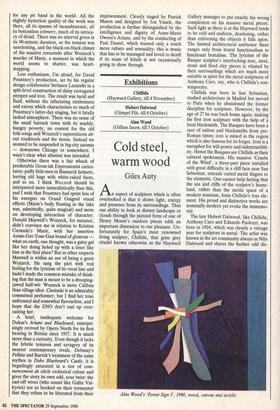Exhibitions
Chillida (Hayward Gallery, till 4 November) Hubert Dalwood (Gimpel Fils, till 6 October) Alan Wood (Gillian Jason, till 5 October)
Cold steel, warm wood
Giles Auty
An aspect of sculpture which is often overlooked is that it draws light, energy and presence from its surroundings. Thus our ability to look at distant landscape or clouds through the pierced form of one of Henry Moore's outdoor pieces adds an important dimension to our pleasure. Un- fortunately for Spain's most renowned living sculptor, Chillida, that grim grey citadel known otherwise as the Hayward
Gallery manages to put exactly the wrong complexion on his massive metal pieces. Such light as there is at the Hayward tends to be cold and uniform, deadening, rather than enlivening the objects it falls upon. The limited architectural ambience there ranges only from brutal functionalism to functional brutalism. The lyricism of the Basque sculptor's interlocking iron, steel, stone and fired clay pieces is vitiated by their surroundings which are much more suitable in spirit for the metal sculptures of Anthony Caro, say, who is Chillida's con- temporary.
Chillida was born in San Sebastian, studied architecture in Madrid but moved to Paris when he abandoned the former discipline for sculpture. However, by the age of 27 he was back home again, making his first iron sculpture with the help of a local blacksmith. The Basques have been a race of sailors and blacksmiths from pre- Roman times; iron is mined in the region which is also famous for its forges. Iron is a metaphor for will-power and indestructibil- ity. Hence the Basques see Chillida as their cultural spokesman. His massive 'Combs of the Wind', a three-part piece installed with great difficulty in a cliff face near San Sebastian, extends curled metal fingers to the elements. One cannot help feeling that the sea and cliffs of the sculptor's home- land, rather than the sterile space of a modern museum, form Chillida's true ele- ment. His proud and distinctive works are nominally modern yet evoke the immemo- rial.
The late Hubert Dalwood, like Chillida, Anthony Caro and Eduardo Paolozzi, was born in 1924, which was clearly a vintage year for sculptors in metal. The artist was known in the art community always as Nibs Dalwood and shares the further odd dis- Alan Wood's 'Forest Sign 1', 1990, wood, canvas ana acrylic tinction of being just about the only artist treated by the prickly painter Roger Hilton with any degree of personal respect. I met Dalwood in Cornwall where he was a fairly regular visitor. It is appropriate, therefore, that the present large-scale exhibition should take place at Gimpel Fils (30 Davies Street, W1), which was such a stronghold for the St Ives avant-garde in former times. Peter Lanyon and Alan Davie were among the distinguished artists shown regularly there. Dalwood's sculpture is at once eclectic yet deeply idiosyncratic. Metal pieces on view range from an early figura- tive work in bronze to aluminium pieces of startling diversity redolent of civilisations ranging from the Celtic to the celluloid.
Aluminium seems to me to lack sculptu- ral gravitas, Dalwood's work often looking metaphorically as well as literally light- weight in consequence. Possibly a sculp- tor's choice of materials signifies more than we realise at first about his or her message and personality. Alan Wood is another artist I knew years ago in Cornwall. He was principally a painter at that time but a long period of living in North America has not only enlarged his scale but pointed him increasingly towards a third dimension. Wood seems drawn naturally to timber. There is plenty of this on the Canadian west coast and the artist used a very generous footage therefrom for an extraor- dinary installation entitled 'Ranch', which was designed for a 320-acre site in Alberta. Luckily here in England the artist has managed to adapt sensitively to the rather more modest indoor scale available at Gillian Jason Gallery (40 Inverness Street, NW1). He has produced a series of col- oured wooden reliefs, about four feet square for the most part, for this his first exhibition in his homeland for many years. Wood is a poet and colourist of genuine talent. His semi-abstract constructions are syntheses of his experience of beautiful wooded landscape near Vancouver. These are impressive works which would make rewarding additions to public or private collections.
After early success in Britain, Wood has come to be acknowledged as one of the senior artists in Canada, where he is to be the subject of a major museum retrospec- tive in Vancouver at the end of this year. Wood's name and work have become largely forgotten in Britain but even on current evidence alone certainly should not be so. Sometimes the format of his col- oured wooden constructions invites com- parison with the work of Howard Hodgkin, who is looked on as a British artist of premier rank. Wood does not suffer in this contrast.



























































 Previous page
Previous page